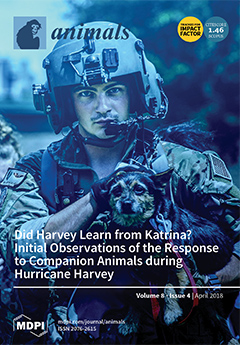Current methods of euthanizing piglets are raising animal welfare concerns. Our experiment used a novel two-step euthanasia method, using nitrous oxide (N
2O) for six minutes and then carbon dioxide (CO
2) on compromised 0- to 7-day-old piglets. A commercial euthanasia
[...] Read more.
Current methods of euthanizing piglets are raising animal welfare concerns. Our experiment used a novel two-step euthanasia method, using nitrous oxide (N
2O) for six minutes and then carbon dioxide (CO
2) on compromised 0- to 7-day-old piglets. A commercial euthanasia chamber was modified to deliver two euthanasia treatments: the two-step method using N
2O then CO
2 (N
2O treatment) or only CO
2 (CO
2 treatment). In Experiment 1, 18 piglets were individually euthanized. In Experiment 2, 18 groups of four to six piglets were euthanized. In the N
2O treatment, piglets lost posture, indicating the onset of losing consciousness, before going into CO
2 where they showed heavy breathing and open-mouth breathing; whereas piglets in the CO
2 treatment did not lose posture until after exhibiting these behaviors (
p ≤ 0.004). However, piglets in the N
2O treatment took longer to lose posture compared to the CO
2 treatment (
p < 0.001). Piglets in the N
2O treatment displayed more behavioral signs of stress and aversion: squeals/minute (
p = 0.004), escape attempts per pig (
p = 0.021), and righting responses per pig (
p = 0.084) in a group setting. In these regards, it cannot be concluded that euthanizing piglets for 6 min with N
2O and then CO
2 is more humane than euthanizing with CO
2 alone.
Full article






